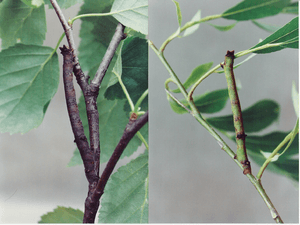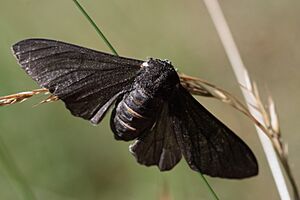Peppered moth evolution facts for kids

The evolution of the peppered moth is a famous example of how animals change over time. For over 150 years, scientists have studied these moths closely. At first, most peppered moths were light in colour. This helped them blend in with light-colored trees and lichens. This blending is called camouflage. It kept them safe from birds while they rested during the day.
During the Industrial Revolution in England, factories caused a lot of pollution. This pollution killed many lichens. It also made trees black with soot. Because of this, the light-colored moths, known as typica, became easy to spot. Their numbers went down. At the same time, dark-colored moths, called melanic or carbonaria, became very common. This happened because the dark moths could now hide better on the sooty trees. The term industrial melanism means that a species becomes darker because of pollution.
Later, as the environment got cleaner, light-colored peppered moths became common again. The story of the peppered moth is easy to understand. It shows clearly how natural selection works. This is why it is often used to teach about adaptation.
Contents
How Melanism Changed Over Time
Melanism means having dark coloring. It appeared in peppered moths in Europe and North America. We don't know much about how quickly the dark moths first became common. But we know a lot more about how their numbers later went down. Scientists measured this using moth traps.
A black peppered moth was first seen in 1811. This was very rare. It was likely caused by a sudden change in a gene, called a mutation. By 1864, the darker 'carbonaria' form was the most common type, or morph, in Manchester. By 1895, almost all (98%) of the moths in Manchester were dark.
From about 1962 until today, the number of carbonaria moths has steadily dropped. Scientists have measured this decline very carefully. Bernard Kettlewell did a big study in 1956. Bruce Grant did another in 1996, and L.M. Cook in 2003.
Similar changes happened in America. However, dark moths have not been found in Japan. This might be because peppered moths in Japan do not live in areas with a lot of industry.
Experiments on Bird Predation

In 1896, a scientist named J.W. Tutt suggested an idea. He thought that birds were eating more light-colored moths in dark areas. And they were eating more dark-colored moths in light areas. This idea is called differential bird predation. Many experiments have been done on peppered moths. All of them have supported this idea, or hypothesis.
The most famous experiments were done by Bernard Kettlewell. He worked with E. B. Ford. In one experiment, Kettlewell put moths into a large outdoor cage. Birds like Great tits ate the moths. In 1953, Kettlewell did an experiment in a polluted forest in Birmingham. He marked moths, released them, and then tried to catch them again. He found that more light-colored typica moths were eaten in the polluted woods. This showed that being dark helped moths survive in dirty places.
Kettlewell did the experiment again in 1955. He went to a clean forest in Dorset and also back to the polluted woods in Birmingham. Niko Tinbergen joined him and they even made a film. Other studies later found similar results. By 1996, research on both sides of the Atlantic Ocean showed a clear link. Changes in moth color matched changes in pollution levels.
Experiments in nature can sometimes feel a bit unnatural. But they still give us important information. Before this, only Ronald Fisher and E.B. Ford had done similar experiments with the Scarlet tiger moth.
Later Experiments
In 2000, another scientist named Majerus planned more experiments. From 2001 to 2007, he worked in Cambridge. He also checked if bats were eating the moths. He found that bats ate both light and dark moths equally. He watched many bird species eating the moths.
Majerus concluded that birds eating moths was the main reason. It explained why the number of dark carbonaria moths went down in Cambridge. He said his results proved the peppered moth story was true. He believed it showed how Darwinian evolution works. He said, "If the rise and fall of the peppered moth is one of the most visually impacting and easily understood examples of Darwinian evolution in action, it should be taught. It provides after all the proof of evolution".
Majerus passed away before finishing his writings. But others completed his work. Their paper said that these new facts gave the best proof yet. They showed that camouflage and birds eating moths explained the changes in moth color. The new information, along with older studies, still shows that "industrial melanism in the peppered moth is one of the clearest and most easily understood examples of Darwinian evolution in action."
Camouflage of Caterpillars

The caterpillars of the Biston betularia moth also have two forms. Each form is good at hiding in a different place. They can change their body colors to match the brown or green twigs of the plants they live on. This is called polyphenism.
Polyphenism is a type of polymorphism. It means different forms of an animal come from the same basic genetic code, or genome. The animal inherits the ability to change. But its environment decides which form it will become. This is different from the adult moths. Their different forms are caused by small differences in their genes.
Polyphenism happens when an animal has a special "switch" in its development. This switch reacts to something in the environment. For these caterpillars, scientists found that seeing certain colors made them change.
Their body color matched the color of light they were exposed to. They can change color until their last stage as a caterpillar. These caterpillars eat many different plants. So, this ability to change color likely helps them hide very well from birds.
Related pages
Images for kids
-
Typica and carbonaria moths on the same tree. The light-colored typica (below the bark's scar) is nearly invisible on this clean tree. This shows how it uses camouflage to hide from predators.
See also
 In Spanish: Evolución de la polilla moteada para niños
In Spanish: Evolución de la polilla moteada para niños




